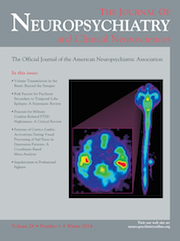A Case of Acute Demyelinating Encephalitis Presenting as Manic Symptoms
To the Editor: Differentiating a manic episode of bipolar disorder from mania secondary to a medical condition in older adults is challenging. The diagnostic dilemma appears when the patient has an established diagnosis of bipolar disorder from a young age. The neuropsychiatric manifestations are similar, and there have been numerous conditions to which secondary mania can be attributed. A thorough differential diagnosis should be considered to help guide appropriate management. Evidence suggests that neurological conditions are the most common causes of secondary mania. In a retrospective study examining 50 manic patients older than age 65, neurological disorders were reported in 74% of the patients.1 We summarize a case of mania that emerged in the context of acute demyelinating encephalitis in an elderly patient with a diagnosis of bipolar disorder since adolescence.
Case Report
A 60-year-old woman was first diagnosed with bipolar disorder at age 16 and was treated with divalproex sodium. She had neither medical nor family history of psychiatric illness. She was admitted for manic symptoms attributed to medication nonadherence. She was treated with lithium 900 mg daily (serum level on discharge was 0.83 mEq/L) and risperidone 4 mg daily. Two months later, she was readmitted because of mood lability and disorganized thoughts for 1 week. She was found to be lethargic and had delirium. Her lithium level was 0.41 mEq/L. Laboratory tests including urine toxicology were negative. Head CT was negative. Neuropsychological assessment revealed impairment in areas of visuospatial and visuomotor functioning, attention, and executive functioning. The neurology consultation found no focal deficits, and brain MRI suggested a demyelinating disease. Lithium and risperidone were stopped, and the patient was transferred to a neurological floor for further evaluation. Video-EEG showed diffuse slowing but no epileptiform activity. Lumbar puncture and paraneoplastic panel were negative. A serial of brain MRI suggested acute demyelinating encephalitis, most pronounced within the frontal and temporal lobes, right greater than left. She was treated with intravenous immunoglobulin and corticosteroid. Her delirium resolved, but she continued to have residual mood symptoms that took several weeks to subside.
Discussion
The frontotemporal involvement in our patient is thought to have contributed to the development of her manifestations. Studies suggest that brain pathology disrupting neural circuits in the right orbitofrontal and temporal cortices has been implicated in mania. Starkstein et al.2 reported predominance of right-sided hemispheric localization of heterogeneous brain lesions, including tumors, strokes, and head injuries in patients with mania.2
The evaluation of manic symptoms in older patients requires a thorough history, laboratory tests, neurological assessment, and neuroimaging. Secondary mania may result from a neuropathological process associated with the underlying condition.3 Multiple sclerosis, Parkinson’s disease, epilepsy, dementia, brain aneurisms, brain tumors, traumatic brain injuries, and cerebrovascular events are the most common brain lesions associated with secondary mania.4 There is a temporal relationship between manic episode and primary medical condition in 20% of patients with a latent period of months-to-years.5
In summary, there is a high rate of secondary mania in older adults that is more likely to be associated with an underlying neurological illness and warrant a comprehensive assessment. Clinicians should collaborate with a multidisciplinary medical and neurological team when manic symptoms develop in an older patient, even though a diagnosis of bipolar disorder was established at a younger age.
1 : Concomitant use of valproate and carbamazepine in bipolar and schizoaffective disorders. J Clin Psychopharmacol 1994; 14:67–70Crossref, Medline, Google Scholar
2 : Mania after brain injury: neuroradiological and metabolic findings. Ann Neurol 1990; 27:652–659Crossref, Medline, Google Scholar
3 : Neuropsychiatric aspects of mood disorders, in Textbook of Neuropsychiatry and Behavioral Neurosciences, 5th Edition. Edited by Yudofsky SCHales RE. Washington, DC, American Psychiatric Publishing, Inc., 2008, pp 1003–1024Google Scholar
4 : Solitary lesion in ponto-mesencephalic area related secondary mania: a case report. Psychiatr Danub 2012; 24:223–225Medline, Google Scholar
5 : Geriatric bipolar disorder, in Principles and Practice of Geriatric Psychiatry. Edited by Agronin MEMaletta GJ. Baltimore, MD, Lippincott Williams & Wilkins, 2006, pp 369–391Google Scholar



